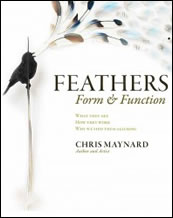Article first published as Book Review: 'Feathers, Form, and Function' by Chris Maynard on Blogcritics.
June 2, 2015
Feathers, Form, and Function:
What they are, how they work, and why we find them alluring
Chris Maynard
Aviva Publishing (2014)
ISBN: 9781940984230
New Art Book Examines Roles of Feathers and Human Fascination With Them
 Since the beginning of time, humans have watched birds, been fascinated with them, and tried to imitate their ability to fly. Few of us, however, take the time to think deeply about Feathers, their function, symbolism, and possibilities. Chris Maynard is an exception. He is an artist who likes to use the image of the Feathers to open up people’s minds and vision to the possibilities of art and new ways to see the world.
Since the beginning of time, humans have watched birds, been fascinated with them, and tried to imitate their ability to fly. Few of us, however, take the time to think deeply about Feathers, their function, symbolism, and possibilities. Chris Maynard is an exception. He is an artist who likes to use the image of the Feathers to open up people’s minds and vision to the possibilities of art and new ways to see the world.
In Feathers, Form, and Function, Maynard offers us the opportunity to re-envision what Feathers are—what is their meaning and purpose—and he complements his words with his beautiful, diverse, inspired, and surprising artwork. While I am not a visual artist like Maynard, but rather a writer, I am always interested and amazed by the works of other creative people and, especially in this case, by the attention Maynard gives to his craft. This book is short but full of thought, and I do not want to give everything away and spoil a real treat for readers, but I will comment on a few comparisons and images Maynard made that surprised and delighted me.
Early in the book, Maynard discusses the design and creation of Feathers in a bird’s body by comparing them to the eruption of Mount St. Helens in terms of how they erupt forth through the bird’s skin. I also appreciated how Maynard compared them to “the wave” pattern made in a stadium by a group of fans. These comparisons at first may seem far-fetched, but they are really very interesting and intriguing comparisons he gives more details on, and they made me marvel at how his artistic mind works.
One chapter that will interest many readers discusses Maynard’s interest in how Feathers are often depicted in tattoos and why people desire them. When Maynard discussed the symbolism of Feathers with a tattoo artist, the artist told him, “There is no main theme.... Feathers mean something individually to each person.”
All this discussion in the book is great food for thought and will hopefully inspire readers to see anew the world or at least our Feathersed friends. But the true delight of this book is Maynard’s artwork. I cannot picture the artwork here, but readers will be surprised by his images and the creative ways he combines Feathers and many aspects of their purpose. The dozens of images all have titles and descriptions. My favorite two images, surprisingly to me, were the ones that depict insects. For the first image, Maynard’s commentary read, “If a bird mainly eats insects to live and build its body, it follows that its Feathers are made of insects.” The image itself shows a Feathers broken into pieces so that insects seem to be moving toward (or away from) it to form (or dissect) the Feathers shape. In the second image, Maynard writes, “And if a bird eats insects and then insects eat the bird, a cycle becomes complete.” This image depicts the cycle of decay and how birds are often the victims of insects upon their deaths. A Feathers broken into pieces like a decaying leaf is surrounded by insects that resemble bees or flies coming to feed off of it.
These two favorite images of mine may be among the more grim ones while other images celebrate the grace and beauty of Feathers. Of course, color is part of Feathers’ beauty and Maynard spends a good amount of space discussing color. He tells us:
“As a visual artist, I am often profoundly aware of the ways colors enhance the world’s beauty. As humans, we have three kinds of cone receptors in our eyes that allow us to see primary colors. Birds have four. They can see ultraviolet and violet colors we cannot. Their eyes are different from ours in other ways too: they can see subtle differences in primary colors. To them, primary colors appear sharper, more vivid. It would seem that Feathers have adapted to utilize the full range of birds’ visual abilities. In other words, to a bird, Feathers are even more colorful. A black Feathers may appear to a bird as a shimmering wonder of violets and blues unknown to us. Imagine my disappointment when I learned this. I want to see like a bird. Instead, I have to settle for using my imagination.”
After reading Feathers, Form, and Function, I think most of us will also wish we could see like a bird, and while that will never be possible, everyone who reads this book will come away seeing birds and Feathers in ways never imagined before. This book is truly a visual and insightful treat not to be missed.
For more information about Feathers, Form, and Function and to view some of the artwork in the book, visit Maynard’s website www.FeatherFolio.com.
— Tyler R. Tichelaar, Ph.D. and award-winning author of Narrow Lives and The Best Place

